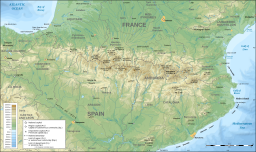Monte Perdido facts for kids
Quick facts for kids Monte Perdido |
|
|---|---|

Monte Perdido (center) and Cilindro de Marboré (left)
|
|
| Highest point | |
| Elevation | 3,355 m (11,007 ft) |
| Prominence | 969 m (3,179 ft) |
| Naming | |
| English translation | Lost mountain |
| Language of name | Spanish |
| Geography | |
| Location | Ordesa Valley, Huesca Province, Aragon, Spain |
| Parent range | Pyrenees |
| Official name: Pyrénées - Mont Perdu | |
| Type: | Mixed |
| Criteria: | iii, iv, v, vii, viii |
| Designated: | 1997 (21st session) |
| Reference #: | 773 |
| Region: | Europe and North America |
| Extensions: | 1999 |
Monte Perdido is a huge mountain in the Pyrenees mountain range. Its name means "lost mountain" in Spanish, French, and Aragonese. It is the third highest mountain in the Pyrenees.
The peak of Monte Perdido is 3,355 meters (11,007 feet) high. It is located in Spain, in the northern part of Huesca province. From France, it is hard to see because other tall mountains block the view. Monte Perdido is part of a mountain range with the same name. It is also found inside the Ordesa y Monte Perdido National Park in Aragon, Spain.
Contents
Exploring Monte Perdido
Monte Perdido has a glacier on its northern side. This glacier is the third largest in the Pyrenees. It is surrounded by very tall cliffs, some as high as 800 meters (2,600 feet).
Like many glaciers in Europe, the Monte Perdido Glacier has been getting smaller. It has been shrinking since the Little Ice Age. Since 1981, the glacier has lost a lot of its surface area. It is melting faster because of climate change.
It is easier to reach Monte Perdido from Spain than from France. Climbers often start near the village of Torla in Aragon. They walk through the Ordesa Valley and up to the Refuge of Góriz. After that, there is a tough climb to the top. This climb can be dangerous, especially when there is snow.
Ordesa y Monte Perdido National Park
Monte Perdido is the main feature of the Spanish Ordesa y Monte Perdido National Park. This park was first created in 1918. It started with only 21 square kilometers (8 square miles) of land.
In the 1970s, there were plans to build a dam in the nearby Añisclo Canyon. This dam would have made hydroelectric energy. However, many people and groups protested against it. They succeeded in stopping the project.
In 1982, the park was made much bigger. It grew to 156 square kilometers (60 square miles). Now, it includes the entire Añisclo Canyon.
Amazing Animals and Plants
The Ordesa y Monte Perdido National Park is home to many different living things. There are over 1,500 types of flowers. You can also find 171 kinds of birds, 32 different mammals, and 8 types of reptiles.
One special bird found here is the lammergeier, also known as the bearded vulture. This bird has a huge wingspan of up to 3 meters (10 feet). The Pyrenees is one of the few places in Europe where you can see these impressive birds.
Because of its amazing mountains and landscapes, the national park was added to the UNESCO World Heritage List in 1997. It is part of the Pyrénées – Mont Perdu World Heritage Site.
See also
- List of mountains in Aragon
- List of Pyrenean three-thousanders
 In Spanish: Monte Perdido para niños
In Spanish: Monte Perdido para niños


